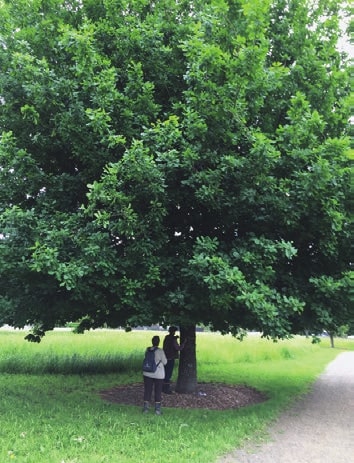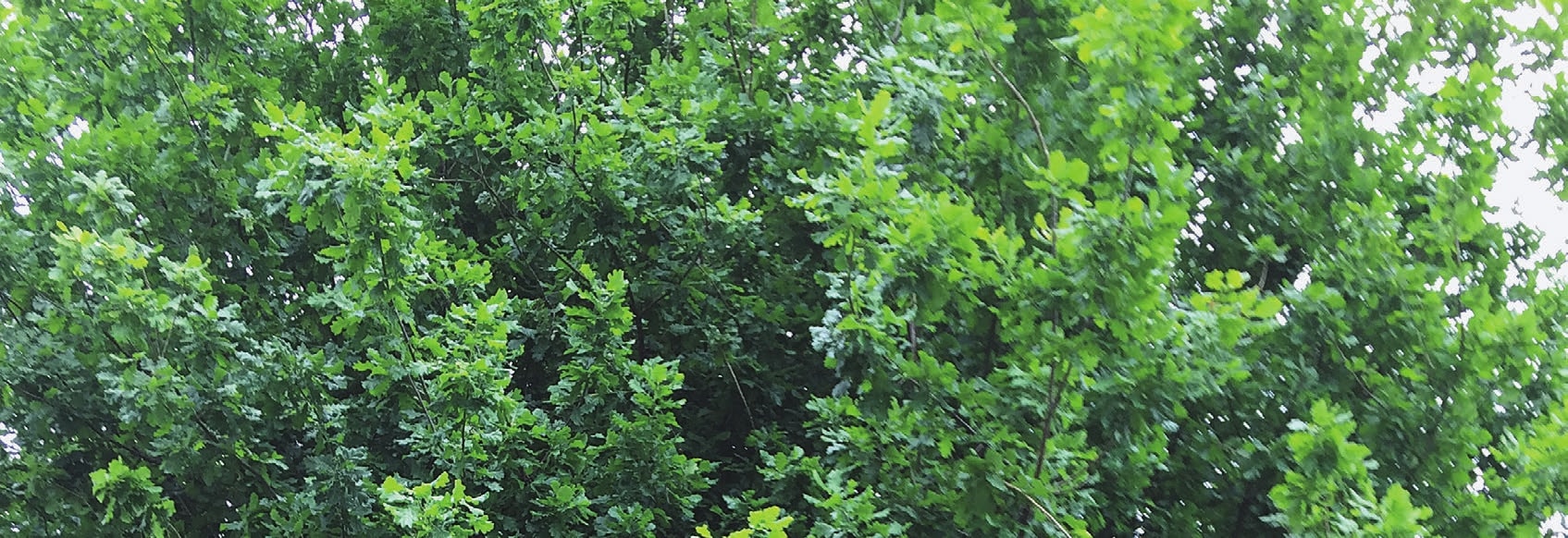Oaks - a new special interest group for the NZFFA?
Kath Hurr, New Zealand Tree Grower May 2019.
Oaks have not featured on the radar in farm forestry circles since the demise of the Hardwood Investigation Group nearly 30 years ago. With the development of new hybrids selected especially for forestry, and trials of new Mexican oak species showing exceptionally good growth and form, oaks deserve much greater attention.
It is clear there are plenty of farm foresters who are passionate about the genus Quercus and much that can be done to improve the availability and selections in New Zealand. Members of the fledgling Oak Interest Group are floating the idea of creating a special interest group for oaks in the NZFFA. Eric Cairns and I from the Wellington Branch will be attending the upcoming conference in Rotorua and encourage any interested members to come and have a chat. In the meantime, for those who are contemplating tree planting this coming winter, here are a few good reasons to choose oaks.
On-farm benefits, resilience and diversity
Oaks are a good fit for integrating into farm forestry, not just for driveway avenues and amenity plantings. Oaks can add to the economics of farming from improved animal welfare, soil productivity, carbon sequestration, firewood and timber. They tolerate a wide range of soils and provide fodder and acorns for birds, deer and livestock.
Oaks are deeply rooted making them among the most resilient trees to droughts and storms. These traits are set to become increasingly important as the climate warms. Some oak species are also well-adapted to fire. They grow slowly and accrue thick bark, and send up basal sprouts after fire and keep growing. At Wither Hills, oak trees burned in the Boxing Day fires of 2000 were coppiced and are now semi-mature trees.
Oaks have a very wide, natural distribution throughout Europe, North America, North Africa, Mexico and Asia. Diversified into nearly every habitat, from the coast to mountain ranges in temperate and sub-tropical zones, there is an oak for every situation. New Zealand has over 140 species of the approximately 600 species worldwide and it would be fair to say that we have not fully tapped the opportunity for matching oaks from different provenances to specific sites and climes here.
New oaks showing promise
Oaks are an important forestry species in the northern hemisphere and are managed in long rotations in Europe, Canada and Japan. They have never been seriously considered as a commercial forestry species here and no systematic selection and breeding work has been attempted.
Tree nurseries have taken the lead in selecting good specimens from private collections, botanical gardens and arboreta around the country and making these more widely available. Appletons Nursery supply a timber from the pin oak Quercus palustris with strong growth and a dominant, central leader, and their hybrid oak Q. robur x petraea is being widely promoted and planted as a purpose timber species.
The Shumard oak Q. shumardii, a red oak from the United States, is another species showing promise in New Zealand. A single 22-year-old hybrid specimen growing in the Wellington region has averaged a growth rate of just over three centimetres a year, with a current diameter at breast height of 67 cm, easily rivalling the growth rates of some of the eucalypts. We wish a whole stand of these trees had been planted at the time, so we could now select the plus trees for further selection work
Mexican species are increasingly being made available for planting, originating from the extensive collection of Mexican oaks assembled by the late Bob Berry at Hackfall’s Arboretum in Tiniroto. Species such as Q. castanea and Q. crispiplis are particularly noteworthy, showing good growth rates and form in some of the driest parts of New Zealand, in Hawkes Bay, inland Marlborough and Canterbury.

| Oak species | Main timber use |
|---|---|
| Q. acuta − Japanese evergreen oak Cyclobalanopsis group |
Japanese martial arts practice weapons such as bokken. Timber has a uniformly tight grain structure from continuous growth. |
| Q. alba − American white oak White oak group |
Valuable timber on a wide range of soils from moist to dry. Slow growing. |
| Q. aliena − Oriental white oak White oak group |
Boat building and wooden flooring. |
| Q. bicolor − Swamp white oak White oak group |
Valuable timber, adapted to wet soils. Maturity 50 years. |
| Q. canariensis − Mirbeck oak Mesobalanus group |
Good timber. |
| Q. candicans − Mexican oak Red oak group |
Good timber, harvested commercially in Guatemala. |
| Q. castanea − another Mexican oak Red oak group |
Highly quality timber. |
| Q. cerris − Turkey oak Cerris group |
Important timber, used for fencing, but prone to cracking and splitting in frosty areas. Tolerates windy, coastal sites. Fast growth. |
| Q. chrysolepis − Canyon live oak Mesobalanus group |
Highly durable wood, used for wheels and farm vehicles in the USA. |
| Q. crassipes − a Mexican species Red oak group |
Highly quality timber. |
| Q. crispipilis − a Mexican species Red oak group |
A major timber tree in Mexico and Guatemala. |
| Q. faginea − Portuguese oak White oak group |
Construction beams and posts. Flourishes in a variety of soils and climates. |
| Q. ilex − Holm oak Cerris group |
Harder and heavier than English oak. Tolerates coastal conditions. |
| Q. imbricaria − Shingle oak Red oak group |
Roof and house shingles. |
| Q. michauxii − Swamp chestnut oak White oak group |
High quality timber, valuable on most soils except extremely wet. |
| Q. nuttallii − Nuttall oak Red oak group |
Commercially important in the USA. |
| Q. palustris − pin oak Red oak group |
Used for cabinetry, furniture, interior trim, flooring and veneer. |
| Q. petraea − Sessile oak White oak group |
Most famously used for French wine-barrels. |
| Q. robur − Common English oak White oak group |
Used as a building material since neolithic times, construction and ship-building. |
| Q. rubra − Red oak Red oak group |
Valuable timber on moist, fertile soil. |
| Q. shumardii − Shumard oak Red oak group |
Valuable timber on good soils, adapted to soils with high pH and wet, but not swampy. Good form and rapid growth. |
| Q. suber − Cork oak Cerris group |
At maturity, the bark of the tree can be peeled every eight to nine years and is the source of wine bottle corks and other cork products. |
| Q. velutina − black oak Red oak group |
Used for cabinetry, furniture, interior trim, flooring and veneer. |
Oaks benefit other tree species
Above ground, forests are a competitive system with individual trees competing for light, moisture and nutrients. Underground a much more cooperative picture emerges. Vast mycorrhizal networks connect the roots of different trees to each other, allowing for the exchange of nutrients, carbon and water.
This network exchange provides a huge boost to the growth of young trees.
Oaks are generalists and share mycorrhizal networks with many other tree species and might usefully be incorporated into mixed forestry stands. In the Yosemite, Canyon live oak Q. chrysolepis shares mycelial networks with Douglas-fir and coastal redwood, with all three species benefitting from the interaction. Douglas-fir and the netleaf oak Q. rugosa grow in mixed forest in some parts of Mexico, giving a Drury land owner the idea of interplanting netleaf oak into a plantation of 1,500 Douglas-fir seedlings which had been failing to thrive for 10 years.
Variety of purpose timbers
Oak timber is noted for its strength, durability and beauty, and is used everywhere for innumerable purposes, ranging from fuel to railroad ties, construction of buildings, interior trim, flooring, tool handles and all grades of furniture as shown in the table.
The woods of different species vary in density and toughness. Fast-grown white oak produces a dense wood which is more watertight than slower-grown oak, making it good for construction and furniture. Wine barrel makers on the other hand want wood which is easy to carve and bend and requires timber with density less than 600 kilograms a cubic metre. French wine-barrel makers purposely selected slow-grown oaks, growing in dense forests and producing growth rings less than two millimetres.
Heinz Vallings of Alternative Timbers in Putaruru has experience with processing and milling New Zealand grown oak, producing both quarter sawn and cut planks.
Due to the large volume of sapwood, he recommends slow air drying over a few years rather than kiln drying. Heinz particularly rates the timber of the holm oak Q. ilex as being very hard and exceptionally beautiful with a medullary-ray fleck.
Truffles and other edible fungi
Oaks are also an important host tree for edible fungi, including the fabulous truffle. Three oak species have been used as hosts in New Zealand for the Périgord black truffle, bianchetto and burgundy truffles. The Himalayan oak Q. leucotrichophora has recently been inoculated and we wait to hear how successful this is. There is still plenty of room for experimentation and we think there is an opportunity to try oak species which naturally thrive on alkaline or higher pH soils. Heavy lime application brings the soil into a more favourable range for the truffle mycelium but can lead to leaf chlorosis.
Oak thinnings and prunings are also a valuable substrate for the cultivation of other edible fungi such as shiitake. The traditional method for cultivating shiitake uses oak logs cut and collected in spring just before bud break. Man-made logs using oak sawdust is another popular method.
A quick note about acorns
Acorns are not poisonous but they are high in tannins and there is some evidence for fatal ingestion in horses, sheep and cattle. A good rule of thumb is to limit animal access to acorns when other feed is scarce or introduce them into the diet gradually over a period of a few weeks, as you would for other fodder crops such as brassica and beet.
Acorns from the white oak group are generally lower in tannin than the red oak group. Acorns can be processed for human food, and many traditional societies depended on them. Tannin needs to be leached out before processing.
Kath Hurr is a member of the Wellington Branch.


 Farm Forestry New Zealand
Farm Forestry New Zealand

